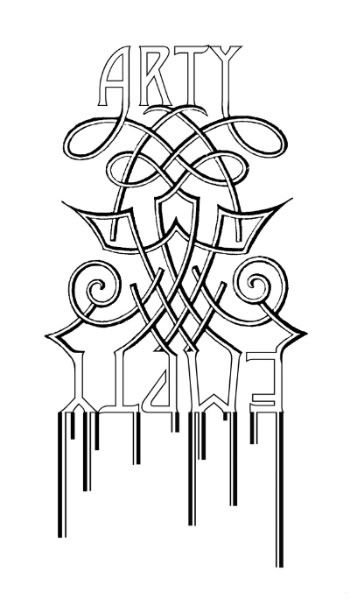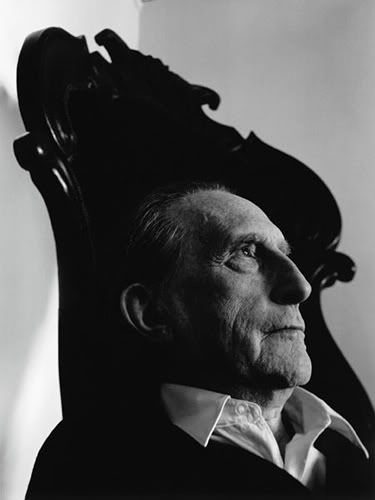L'exposition Traces du Sacré au Centre Pompidou de Paris (7 mai - 11 août 2008) a laissé de sacrés traces. L'interrogation sur la place, la disparition puis le retour du "sentiment religieux" dans l'art est un sujet délicat. D'autant plus dans nos périodes troubles. L'art a souvent trait à une certaine métaphysique et l'auteur du miracle créatif, l'artiste, se trouve vite propulser au rang de chaman, prêtre, pape ou dieu. Si le dernier "art chaman" (auto)déclaré est Matthew Stone, le siècle passé en est truffé. De Beuys, l'aventurier ressuscité à Malevitch, le pionnier suprématiste en passant par Hirst, Rothko, Acconci.... les candidats au poste ne manquent pas.
Mais, on ne sait pour quelle raison, deux noms reviennent plus que les autres sur les 5 000 dernières années de création (consciente disons), ce qui laisse pourtant pas mal de monde (dont un paquet de beau linge...). Les deux élus : Marcel Duchamp et Andy Warhol.
On sent déjà se crisper le lecteur, anxieux : "Ne me dites pas qu'il va oser dire du mal de Warhol et de Duchamp quand même ?...". Crime affreux, impardonnable, violation digne de caricatures mal senties, condamnation immédiate, exécution.
Bien sûr que Warhol comme Duchamp sont deux génies absolus de l'art moderne et bien souvent élevés au rang de divinités factices pour de mauvaises raisons. Mais entre le publicitaire designer de chaussures et le roi du "Dis plus rien, Marcel, z'y voient qu' du feu… La fermer, c'est l'assurance de ne pas dire de conneries !", il semblerait qu'il y ait une relecture possible de l'histoire à faire.
Et dire que les deux pauvres malheureux n'y sont pour rien..... ou presque. Bien sûr, ils ont tous deux concourus volontiers à la glorification de l'aura de l'artiste et à la mythification de son travail.... jusqu'à la fossilisation. Ils n'en espéraient (peut-être) pas tant. Un exemple parmi tant d’autres. « Theft is Vision » (éd. JRP/Ringier) de Robert Nickas, excellente collection d’articles et interviews du critique et curateur américain. Seul Hic : la moitié des articles voient citer Duchamp et deux tiers évoquent Warhol (solidarité américaine sans doute…). N’y a-t-il vraiment personne d’autre à se mettre sous la dent, ou disons plutôt, sous la plume ?
Cette divinisation des artistes peut prêter à sourire. Elle est pourtant le reflet d’une tendance plus large. Si la jeunesse semble découvrir l’ « Allelujah » brisé et glacé de Leonard Cohen par Jeff Buckley, en rotation radiophonique si forte qu’elle vous en ferait vomir votre hostie, c’est dans la continuité d’une société qui est en passe de retrouver la foi en un Dieu mort depuis Nietzsche. Un rattachement à la religion n’est jamais anodin et apparaît bien comme le signe de la perte de repères et de références. Dans ces cas, autant s’attacher à ceux qui ont fait leurs preuves…. Comme Andy et Marcel.
A cette « duomanie » pathologique, d’autres ont choisi de jouer la carte de la variété et de la dispersion. Par exemple, l’exposition « From the voice to the hand » de Melik Ohanian (référence au « From Hand to Mouth » de Nauman repris par Marclay dans « From Hand to Ear » ?) au Plateau, Paris, du 18 septembre au 23 novembre 2008. Une longue suite de néons blancs éclaire à mi-hauteur des petits tas de lettres posés au sol ou mis à l’écart le long des murs. Au-dessus des néons, une longue litanie de noms, véritable aréopage de philosophes, penseurs et autres écrivains érudits. On vous dévoile la surprise : le tas de lettres correspond aux signes composant une citation du personnage annoncé au-dessus. Trop simple à retrouver me direz-vous ? L’artiste a bien pris soin de retirer une lettre afin de compliquer un peu la tâche… Ouf ! Nous voilà rassurés ! On va pouvoir s’amuser un peu…. L’installation est belle, l’artiste est bon (habituellement), là n’est pas le problème. L’œuvre ne permet aucunement d’accéder au propos, elle semble se dresser comme un rempart, stérile, inutile. Elle est le symbole de la multiplication à l’excès des points de contact historiques. Cette tendance lourde de l’art actuel, depuis l’éclosion du post-modernisme dans son acception artistique au début des années 1980, peut être résumée sous le titre de « name-dropping ». Accumulation citationnelle de personnalités, artistiques, littéraires ou issues du champ culturel. De quoi se rassurer et combler parfois un vide dans le sacro-saint discours sur l’œuvre. Ce ne sont, une fois de plus, pas les référents qui sont en cause, ce sont leur utilisation. Certains artistes font ça très bien et à bon escient…. d’autres non. Précisément, l’amoncellement jusqu’à l’incompréhension ne sert à rien. Dans ces cas là, autant juste citer… Warhol et Duchamp.
In the future, Duchamp and Warhol will be famous for… eternity.
The exhibition « Traces du Sacré » at the Pompidou Center , Paris (May 7th – August 11th 2008) left traces. Questioning the place, disappearance and return of a « religious feeling » in art is a delicate interrogation. And particularly during such confused times as ours. Art is often linked to metaphysics and the miraculous and creative author, the artist, becomes rapidly somewhat of a shaman, a priest, a pop, a god. The latest self-declared “art shaman” is Matthew Stone but there were dozens of them in the last century. From Beuys, the adventurer risen from the dead, to Malevitch, the supremacist pioneer, via Hirst, Rothko, Acconci…. The waiting list grows.
But, somehow, two names keep coming back regularly, or at least have been for the last 5,000 years of (conscious) creation. That’s a lot of people, including a few stars… But only two chosen ones remain: Marcel Duchamp and Andy Warhol.
Here comes the anxious reader, thinking frantically: “You are not going to speak evil of Duchamp and Warhol…. How dare you?” A dreadful and unforgivable crime, a violation, like those (Divine) bad taste caricatures. Immediate condemnation. Execution. Of course, Warhol and Duchamp are two mere art genius and often empowered as factice gods for bad reasons. Somewhere between the shoe designer and the king of “Be quiet, Marcel! They don’t get it. Shut up, and you won’t say crap!” strategy, we could consider a new historical approach.
One might even think that they were two unhappy innocent creatures. Well, not that innocent. They both obviously wanted to be glorified and to attain mythical work… until fossilization. Maybe they didn’t claim for such a result. Let’s take an example. “Theft is Vision” (JRP/Ringier ed.) is a great collection of articles and interviews by art critic and American curator Robert Nickas. There’s the snag: half of the articles quote Duchamp and two-thirds of them quote Warhol (probably due to American solidarity….). Is there really nobody else to speak about, or to write about?
This kind of artistic deification could be laughed at. However, it reflects a larger trend. Young people in France are discovering Leonard Cohen’s cold and broken “Hallelujah” as covered by Jeff Buckley. The heavy on-air rotation could make you spit up your Host. Society seems to regain its faith in a post-Nietzsche dead God. Such a return to religion is never neutral and appears to be the sign of our loss of marks and referents. In this instance, you’d better hold on to trustworthy people… Like Andy and Marcel.
Opposed to this pathological “duomania”, some artists choose variety and dispersion. Take the exhibition “From the voice to the hand” by Melik Ohanian (does it refer to Nauman’s “from hand to mouth” covered by Marclay’s “from hand to ear”?) at the Plateau, Paris, from September 18th to November 23th 2008. A long line of white neon lights enlighten small piles of letters (as in a-b-c, not mail) put on the floor or grouped together along side walls. Upon the neon lights, a long litany of names, a learned assembly of philosophers, thinkers and erudite writers. We’ll reveal the surprise: the piles of letters refer to a quote by each personality named above. Too easy for you? The artist has taken a letter from each pile in order to complicate the game…. Ok, that’s much better now! Let’s play! The installation is beautiful, Ohanian is (usually) a good artist, that’s not the issue. The piece does not allow any sort of comprehension. It is a fruitless, useless rampart. It symbolizes the excessive multiplicity of historical gathering points. This is a massive trend in art since the rise of artistic post-modernism at the beginning of the 1980s, known as name-dropping. An accumulation of quotation including names of people, artists, writers or cultural personalities. A way to reassure yourself and fill up an embarrassing void on sacrosanct speech about your work of art. While the referents are not judged, the way some artists use them, is. Some artists know what to do with them, some of them don’t. More precisely, storing up references to the verge of incomprehension is nonsense. In that case, it’s better to quote just… Warhol and Duchamp.



Aucun commentaire:
Enregistrer un commentaire